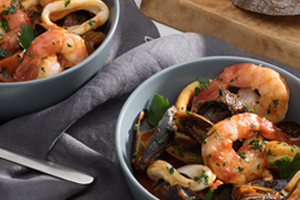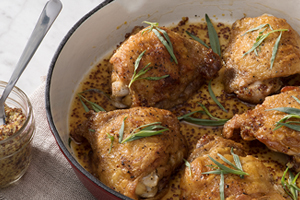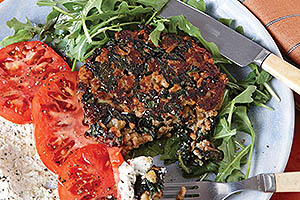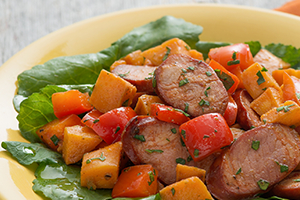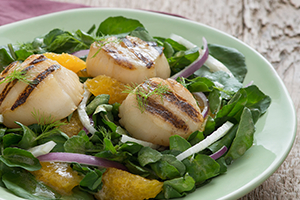
- Preheat oven to 400ºF. Pat tenderloin dry with paper towels; spread pesto all over pork tenderloin. Wrap pork with prosciutto slices to cover completely. Secure with toothpicks.
- Place on foil or parchment paper–lined baking sheet. Drizzle with olive oil and season with pepper. Roast for 25 to 30 minutes or until internal temperature reads 160ºF and prosciutto is crisp. Tent loosely with foil; let stand for about 5 minutes or until internal temperature reaches 165ºF. Serve with additional pesto if desired.
Tip: Serve with brown rice and sautéed spinach or greens.
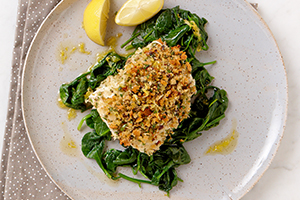
This easy and satisfying fish dish features a crunchy topping that does three things: It has great flavor in the classic Moroccan combination of lemon, olives, and herbs; it provides a crunchy textural contrast to the soft fish; and it keeps the fish moist by sealing in steam. A super easy and flavorful finish of lemon-infused oil and a bed of spinach make this a weeknight main dish elegant enough for a party, too.
- Heat the oven to 425 degrees F. Stir together the mayonnaise and mustard and set aside.
- In a small bowl, combine the breadcrumbs, olives, parsley, 2 tsp. of the olive oil, 1 1/2 tsp. of the lemon zest, a big pinch or two of ground cumin, and a pinch of salt. Stir to combine thoroughly.
- In a separate small bowl, combine 2 Tbs. olive oil with the remaining 1 tsp. lemon zest.
- Rub a shallow baking dish (we suggest 9×13) with 1 tsp. of olive oil. Arrange the lemon slices in the baking dish and top each with a piece of fish. Season the fish with a little salt and pepper. Coat the top and sides of the fish with the mayo-mustard mixture. Mound and pat the breadcrumb mixture over the top and sides of the fish until well-coated.
- Roast the fish for 20 to 22 minutes, or until the crust on the fish is deeply golden brown.
- In a large skillet, heat 1 to 2 tsp. olive oil over medium heat. Add the baby spinach and a pinch of salt, and cook, stirring and flipping with tongs, until wilted, about 2 minutes.
Transfer the spinach to four serving plates, drizzle with a little of the reserved lemon oil, and top with a piece of fish. Drizzle a little more lemon oil around and over each piece of fish. Serve right away with lemon wedges, if you’d like.
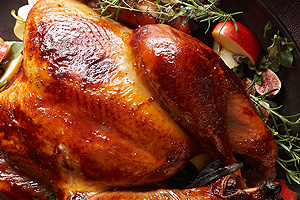
Gone are the days of the dry, tough, and stringy Thanksgiving Day bird. Enter the brined turkey. Brining decreases moisture loss by 30 to 40 percent, and using cider adds to the taste. Brushing olive oil on the turkey before and after roasting results in fabulous depth of flavor.
BRINE THE TURKEY
- Combine 1 gallon plus 1 quart of the apple cider and the remaining brine ingredients in a 12-quart nonreactive pot and heat on high heat until the sugar and salt dissolve. Let cool.
- In the meantime, remove the giblet package and neck from the bird and refrigerate for later use in the gravy.
- Trim away any excess skin, if desired. Submerge the turkey in the brine, breast side down (it’s OK if the back bone pops up above the brine), cover, and refrigerate for 13 hours or up to one day.
- Heat the remaining 3 quarts of apple cider in a 5-quart pot over high heat until reduced to 3 cups, stirring occasionally, about 1½ hours. Remove from the heat, and let cool.
MAKE THE TURKEY
- Position a rack in the lower third of the oven and heat the oven to 325 degrees F.
- Remove the turkey from the brine and wash thoroughly inside and out. Pat the skin and cavity dry with paper towels. Squeeze the lemon into the cavity, and rub the cavity with the juice to coat. Put the two halves of the squeezed lemon, the thyme, sage, and rosemary into the cavity. Truss the legs with kitchen twine, and tuck the wings behind the neck.
- Put a V-rack in a large shallow roasting pan and put the turkey on the rack, breast side up. Brush the turkey with ¼ cup of the olive oil. Roast until the turkey registers 165 degrees F, 3 to 3¾ hours. If the turkey begins to get too dark on top, tent it loosely with foil. Remove the pan from the oven. Whisk the reduced cider with the remaining 2 Tbs. olive oil, ½ tsp. salt, and ½ tsp. pepper. Brush the turkey with the olive oil-cider mixture, tent with foil, and let the turkey rest for at least 45 minutes and up to 1 hour before carving.
- Serve with Madeira Cider Gravy.
TIP: MAKE AHEAD
The cider can be reduced up to 1 week in advance and stored in a covered container in the refrigerator. Warm on medium heat before use.
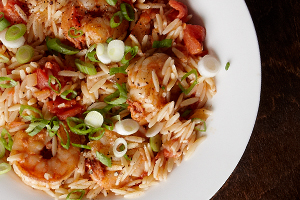
Add this quick and tasty recipe to your stable of go-to weeknight meals.
- Toss the shrimp with 1 Tbs. of the olive oil in a medium bowl and the Cajun spice mix, making sure that the shrimp is evenly coated.
- Heat 1 Tbs. of the olive oil in a 12-inch skillet over medium-high heat until shimmering. Add half of the shrimp and cook until they start to turn bright pink, about 1 minute. Turn and cook on the other side for another 30 seconds, or until just cooked through. Transfer the shrimp to a plate and repeat with the remaining shrimp, adding more oil if necessary. Transfer the second batch of shrimp to the plate and reserve.
- Add the remaining 1 Tbs. oil to the skillet over medium heat. Add the onions and cook, stirring often, until they begin to brown, about 5 minutes. Add the wine and cook until the pan is dry, about 5 minutes. Add the tomatoes and garlic, and cook, stirring occasionally, for 10 more minutes. Add the shrimp and the cream to the sauce and heat through, being careful not to allow the sauce to boil.
- Meanwhile, bring a large pot of well-salted water to a boil. Cook the orzo according to package directions until al dente. Drain, reserving 1/2 cup of the cooking water.
- Toss the shrimp sauce with the orzo and transfer to a large shallow bowl. Add a little of the cooking water to loosen, if necessary. Top with the scallions and serve with hot sauce.
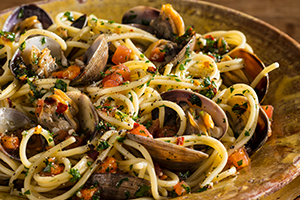
- Discard any clams that are open or have broken shells. Place clams and wine in a 12- to 14-inch sauté pan set over medium-high heat; cover and cook for 5 to 7 minutes or until clams open. (Discard any clams that do not open).
- Reserve 6 to 8 clams in the shell for garnish; set aside. Remove shells from remaining clams over fine-mesh sieve lined with damp cheesecloth set over a bowl. Add clams to bowl with juice; set aside.
- In large pot of boiling salted water, cook vermicelli for 3 minutes or until al dente; drain well. Meanwhile, return sauté pan to stovetop; add olive oil and heat over medium heat. Stir in garlic and red pepper flakes; cook for 1 minute or until garlic is softened. Add tomatoes and reserved clam juice; cook over medium-low heat for 2 minutes. Stir in clams; season with salt and pepper to taste.
- Add vermicelli to sauté pan; reheat slowly, mixing well. Stir in parsley. Transfer vermicelli to serving platter and garnish with reserved clams in the shell. Serve hot.
Recipe provided by Chef Mary Ann Esposito
